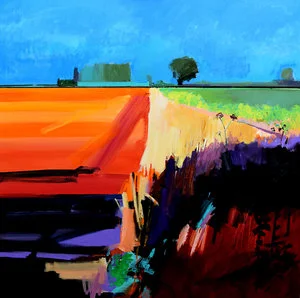RICHARD POUSSETTE-DART AT KETTLE'S YARD
Richard Poussette-Dart, the American abstract expressionist, has long been eclipsed by his stellar contemporaries. Mark Rothko, William de Kooning and spectacularly Jackson Pollock made it into the mainstream and became celebrated as the New York School - but the brilliant visionary with a passionate pacifism at his core and a strongly held Christian belief system as his deep resource was not so well recognised. Was it his reticent nature? Or his unworldly approach to art - the words ‘not for profit’ appear occasionally in his letters? Or was it down to the critics? Clement Greenberg adored Pollock - his flamboyance and bravado and his anarchic energy appeared to represent the post-war defiance of his day. Greenberg the most influential writer of taste in the 40s and 50s simply blocked out Richard PD - even though the artist was bought by luminaries like Peggy Guggenheim and his patroness, Betty Parsons.
Kettle Yard’s founder Jim Ede is the key to this show and its starting point. In 1931 Richard Poussette-Dart read Ede’s study of sculptor Gaudier- Brzeska ‘The Savage Messiah’. Immediately he connected with the ideas in it and began a correspondence with Ede lasting over 30 years. Within the 200 letters emerges their close harmony of ideas from music (Bach and Beethoven ) art and spirituality. Jim Ede sent ‘Dick’ some shells (quintessential Kettles Yard inspiration) and the young American replies in rapture “How the Universe, how God is revealed in this little bit of assymmetry (sic)”. Here is clearly a meeting of minds between the Cambridge custodian and collector and a New World artist whose inner thoughts are more echoes of poet Gerard Manley Hopkins in his priestly isolation, than Pollock and his defiant art group, ‘The Irascibles’ - angry with the New York Metropolitan Museum of Art for its rejection of abstraction. In 1950 he was photographed with the young rebels and much of his work parallels (or even anticipates) their’s. He was an accomplished photographer for Vogue and his high resolution prints form an intriguing section of this deceptively expansive show. I liked the self portrait in his studio. At first glance there’s no one there. But then the sober handsome face emerges from a clutter of canvases and sculptures. Typically hiding in plain sight.
One entire gallery displays RPD’s masterly Cubism; pictures easily paired with Picasso’s show his skill - and vision, whilst Gaudier Brzescka’s 1914 Bird swallowing a Fish (a prize part of the Kettles Yard Collection) comes to mind in the sculptures based on Native American totemic art. Elsewhere there is an inventive layering of forms within a rectangular structure - most powerfully in his Cruxifiction a work of 1944 which conveys his protest against atomic firepower. Exquisite brass miniature sculptures appear almost as components of these large scale paintings: ‘Within a Room’ illustrates the significance of these small objects in the writer’s mind, something Curator Jennie Powell illustrates in an accompanying photograph of all the mini- sculptures. RPD fashioned one for especially for Jim Ede. He kept it with him as a talisman when travelling and it now lives, carefully placed, within the Kettles Yard house, Ede’s personal collection of art.
The massive pictures in the exhibition from 1950 demonstrate RPJ ahead of the abstract impressionist game. Before his confrères had gone giant-sized, he produced vast contemplative paintings, so enormous he struggled to exhibit them anywhere. Circles spiral in fastidious pointillist layers to evoke the range of the artist’s devout religiosity from Zen Buddhism through Christianity - and into the void, where as he saw it, God’s universe takes us into His creation.
Kettles Yard have followed the thread of a correspondence through to a complex artist’s early work. He may not be well known or much celebrated, but here is a meditative collection as much a reflection of twentieth century life and thought as it is of our own day.
Cruxifiction 1944
Presence, Ramapo Mist, 1969.
Four brass rings and one jade ring, circa 1940-1950.










